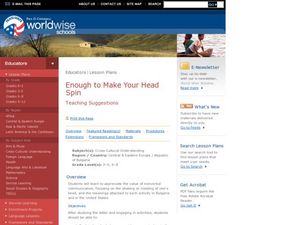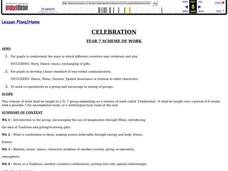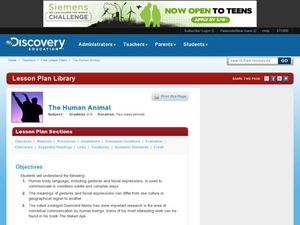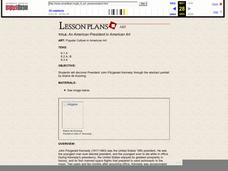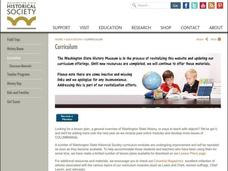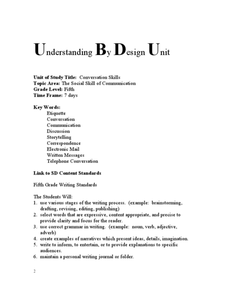US Institute of Peace
Nonverbal Communication
What is your body saying that maybe your words aren't? Scholars explore the vast world of the subtle, and not-so-subtle, nonverbal communication cues through group and individual work. Lesson seven in a series of peacebuilding exercises...
Curated OER
Enough to Make Your Head Spin
Young scholars investigate the world of nonverbal communication by analyzing body language around the world. In this cultural communication instructional activity, students research the Bulgarian language and how we could easily...
Curated OER
Sign a Map
For this geography worksheet, students think and identify the different features and landforms that an explorer would come across the continent of Antarctica. They use body gestures to communicate their list of items to a partner and...
Curated OER
Celebration
Students identify the different ways in which different countries celebrate and why, including story, dance, music, and exchanging gifts. Then they develop a basic standard of non-verbal communication through either dance, mime,...
Curated OER
The Human Animal
Students explore non-verbal communication. In this animal communication lesson, students study body language and other forms of non-verbal communication. Students write a summary of their findings to discuss with the class. This lesson...
Curated OER
A Gesture Is Worth a Thousand Words
Students share observations on the nuances of meaning in face to face and online interactions with others. After reading an article, they identify the causes and effects of internet flaming. They create their own comic strips...
Curated OER
What Did You Say?
Students investigate how the Indians and Europeans first met and their first interactions using spoken language. Before speaking the class warms up to the idea with the use of body language and gestures. Then the teacher sets the scene...
Curated OER
An American President in American Art
Learners discuss the life and death of both Elaine De Kooning and the president she painted, John Kennedy. They learn how Kooning chose to describe President Kennedy through abstract expressionism and why her choice of color and...
Curated OER
Discourse
Explore the different types of discourse and language with your lecture students in this presentation, which explores "sweet language," "stuffy language," and "poetic language," among others. Helpful for English, Sociology, Semantics, or...
Curated OER
Challenge to Communicate
Students use Lewis and Clark's journals to identify the forms of non-verbal communication they used. They discover the problems they faced on their journey and how they overcame them. They practice using the non-verbal language of the...
Curated OER
Theatre Lesson Plan- Tableau (part 2)
Students explore tableaux. In this social studies and fine arts cross curriculum lesson, students work in groups of four to create "frozen" stage pictures (tableaux) representing vocabulary and concepts from a "From Farm to You"...
Curated OER
HIV/AIDS and Development
In this global issues worksheet, students conduct research on the the status of AIDS/HIV treatment in the world and respond to 4 short answer questions related to the topic.
Curated OER
Effective Speaking in a Debate
Students examine and discuss the concept of stage fright. They demonstrate positive debate techniques, constructively critique other speakers, and implement debate techniques for a practice debate.
Curated OER
Family Communication Style
Eighth graders explore the different ways that families communicate with each other. After a lecture/demo, 8th graders generate a list of relationships that might benefit from practice in the art of conversation and communication.
Curated OER
What Really Happened?
Sixth graders recreate scenes from the theories about the disappearance of Amelia Earhart. In this history and theatre activity, 6th graders review the story of Earhart using a flip chart. Students work on one act plays to depict one of...
Curated OER
Theatre Lesson Plan - Pantomime
Second graders study heroes, inventors, and explorers and role-play as one of the people. In this theatre and history lesson, 2nd graders review the people and their accomplishments using a Promethean flipchart. Students then act out one...
Curated OER
The Social Skill of Communication
Fifth graders explore communication by analyzing manners. In this social skills lesson, 5th graders review the different forms of communication and how to present yourself in a phone conversation, face to face meeting, e-mail, etc....
Curated OER
Anger Management
Students discuss anger triggers and how they know they are getting angry. In this anger lesson plan, students discuss anger vocabulary and how to calm themselves down.
Curated OER
The Artist As Entrepreneur: You Say Tomato, I See Tomato
Young scholars compare phone negotiations with in person negotiations to identify the non-verbal communication that is produced in face-to-face meetings. They practice forms of non-verbal communication by reciting the alphabet and...
Curated OER
Helping Your Community-Sharing Stories
In this activity, students in groups will assemble a story bag, which contains objects that represent some type of story to them. Students will then practice sharing these stories in a dramatic fashion.
Curated OER
Mardi Gras Madness
CStudents create a sensory chart in on the topic of Mardi Gras. They design a brainstorm web using Inspiration and complete creative writing assignment. Students write a poem about Mardi Gras that is presented to the class at the final...
Curated OER
Puzzle Rectangles
Students work in small groups to complete a rectangle puzzle without any verbal communication or hand signals.
Curated OER
Challenge to Communicate
Students examine the journals from Lewis and Clark and identify how they spoke without using words. They participate in a game in which they use non-verbal communication with each other. They write their own journal entries to complete...
Curated OER
Extracts from History of Germany in the Nineteenth Century and Historical and Political Writings
In this World War II worksheet, learners read a 2-page selection from History of Germany in the Nineteenth Century and Historical and Political Writings by Heinrich Vot Treitschke and then respond to 4 short answer questions...

